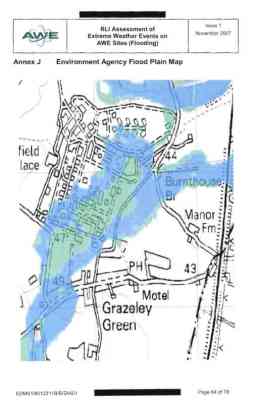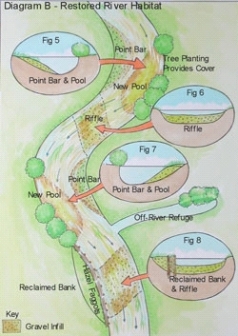Technology is capricious. It helps humanity take one step towards tackling flooding before promptly upping the ante on the value of what will be lost if the levee breaks. In an attempt to reduce losses, we adapt to flood risk by building better meteorological models and GIS that can predict storm events and run-off levels more accurately. But then we site a sensitive nuclear weapons processing plant on an active flood plain. As one might imagine, such contradictory practices make building resilience a tougher task for Britain in the long run.

Environment Agency Flood Plain Map (the majority of buildings belong to the AWE site)
A new report by UK TV Channel 4 suggests that the extreme rainfall of July 2007 came closer to causing a nuclear “criticality incident” than facility managers admit in their official report on events at the Atomic Weapons Establishment (AWE) in Burghfield near Reading. 83mm of rain fell in just 5 hours. The monthly average for this region is just 59mm, making this an estimated 1 in 215-year return event. The plant was left out of action for nearly nine months after water “came close to overwhelming” buildings and bunkers where Trident nuclear warheads are assembled and maintained. Eighty-four buildings were flooded, some to a depth of two feet.
Water vapor accelerates the oxidation of plutonium by oxygen and reacts directly with the metal. For this reason, plutonium metal is routinely handled in a very dry atmosphere. The Channel 4 report logically argued that “full or partial flooding” could have led to the release of radiation across nearby towns. Yet AWE say that “at no time was there any threat to the nuclear safety of the site.” However, confidence in what AWE actually say appears to have waned following another important disclosure. It appears that after previous floods at Burghfield in 1999 and 2000, a programme of nine separate flood remediation measures was ordered – none of which had been completed at the time of the latest flood. Resilience rating? Must try harder.





 Trout are fussy fish.
Trout are fussy fish.  A
A  The UK’s annual Chelsea Flower Show (CFS) is doing its bit for flood damage limitation. Too many lawns, it seems, have falling foul of a popular fashion for paving and decking – thanks to a hydrologically disastrous decade of
The UK’s annual Chelsea Flower Show (CFS) is doing its bit for flood damage limitation. Too many lawns, it seems, have falling foul of a popular fashion for paving and decking – thanks to a hydrologically disastrous decade of  Thanks to its logic-defying global networks, the bottled water industry provides no shortage of insightful perspective on contemporary trends in superfluous consumption.
Thanks to its logic-defying global networks, the bottled water industry provides no shortage of insightful perspective on contemporary trends in superfluous consumption.